Turning Twitter into a Lead-Generating Machine: Making the Blue Bird Lay Golden Eggs

How Aleksandr Volodarsky of Lemon.io turned Twitter into a primary lead generation tool in 2020 by making his company’s business development a public issue.
In 2022, web development engineers from 20+ countries have worked 280 000 hours through Lemon.io. It was a tremendous 2x boost from 148 000 hours in 2021. Despite the full-scale Russian invasion in Ukraine and global recession, the marketplace connecting vetted developers with Western startups continues to grow. Every week, its founder’s Twitter has been bringing Lemon.io more than 50% of leads.
How to generate leads on Twitter, and what strategy to choose for your social media presence? What are the core rules, dos and don’ts? In this guide, I’ll share the experience of Aleksandr Volodarsky, CEO of Lemon.io, who once decided to make his business results transparent and use Twitter as a lead-generating tool.
Why is Twitter a perfect platform for lead generation?
In 2020, Aleksandr Volodarsky attended a MasterMind for business owners, where a couple of notable digital entrepreneurs shared their thoughts about social media ways of getting clients.
They gave Volodarsky the idea of business-building in public.
What did they share?
- Your brand gains positive visibility when you share all the experiments, processes, and metrics of your business development on your Twitter profile.
- Quite often, entrepreneurs are reluctant to share their insights and business details — but they would gladly peek into others’ ways of doing business and share thoughts with their shrewd comments. All the participants in this process win.
- If your followers need a product or service you sell, they will probably address you sooner rather than later since they know a lot about your business.
Three reasons to use Twitter for marketing and lead generation
- The tech community is predominantly Twitter-based. Many CTOs use it to share business ideas and get peer feedback.
- Unlike Quora or Reddit, Twitter values the real identities of its users. It’s useful for entrepreneurs and their brand building.
- Twitter is excellent for building steady long-term relations with your audience through likes, shares comments, subscriptions, and lists.
Many companies and corporations use Twitter to enhance their online brand presence. However, they often misuse it — understanding it as one more landing page with keywords and clickbait aimed at Twitter users.
What do they do wrong?
- Advertising instead of engaging
You’ve seen it zillions of times: a company hires SMM specs who pump your feed with its branded banners and keyword-obese statuses — turning Twitter accounts into digital billboards.
- Redirecting audience to their web page
Those who share a link to their corporate website in each tweet are nasty and obtrusive — firstly, because Twitter users want to get the content RN, and lastly, because they love smart plots and rarely care about noisy ads. For Twitter users, this social media is the content ecosystem per se, and each external link disrupts this inherent principle.
- Posting from companies, not from people
We all love the human approach and trust individual insights more than corporate “materials.” They tap into our experience and bring much more engagement (in both human and Google Analytics terms).
- Distributing links instead of ideas
The ultimate aim of marketing is to build trust and help people relate to your ideas, not share links. If you do the latter, you’ll be inevitably accused of marketing (and ostracized). On Twitter, link publishers should deserve trust first.
Before starting to uncover his business online, Volodarsky has examined a few notable cases of entrepreneurs doing transparent business and sharing their business ideas and results online. One of these was Pieter Levels from NomadList, who posted about his one-person business with no employees.

How did a business building in public look like at the beginning?
In 2020, three founders of Lemon.io planned for their company to grow to 10M GMV, and Aleksandr Volodarsky announced the aim everywhere he could — to make it public, intriguing, and followable. At that time, he had 200-400 Twitter followers and didn’t arrange his messages into a system. Everything needed to be corrected and made efficient to turn into an efficient set of Twitter strategies.
Volodarsky posted on similar topics as famous businessmen who succeeded at audience building, and wrote dozens of business insights threads. He used Tweetdeck for tracking thought trends and opinion leaders. The thread about his mistake of taking angel investments became one of his first viral threads.
Before getting his first thousand followers, Volodarsky received 1-2 Twitter leads a month. He reposted and commented on popular posts by entrepreneurs, where he could add valuable information to the topic starter’s idea. Then came a quality breakthrough.
In December 2022, Lemon.io went into aggressive working mode. After half a year of rise, clients became sparse, and the company’s primary mission is to overcome this chasm. All the company members’ work is now aimed at multiplying the lead count. Each morning, founders share the previous day’s statistics. Many leads come from Volodarsky’s Twitter and his target audience.
March 2020: 200-400 followers, 1-2 tweets a week, no strategy, 1 lead/month
February 2023: 49K followers, 5-10 tweets a week, thorough content strategy, ~50 leads/month
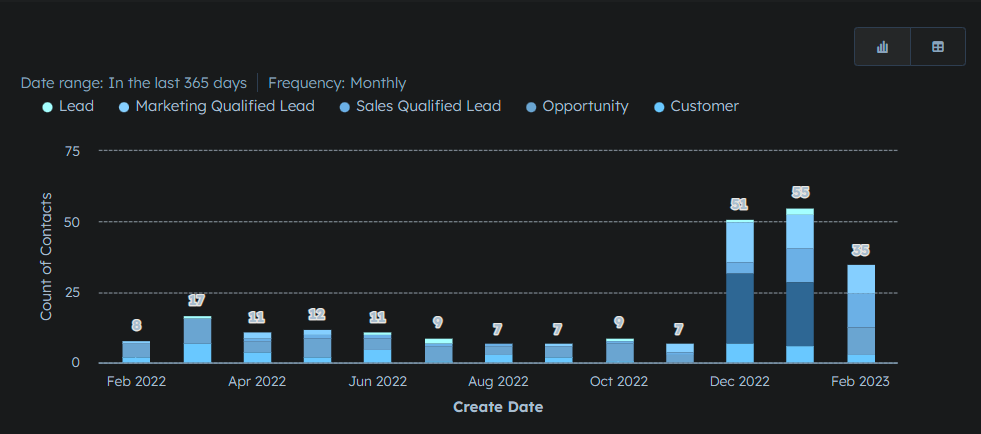
100M GMV aim turned out to be a weaker message than +100 clients in aggressive mode. Lemon.io’s daily progress thread gets new likes, favs, and retweets as the aim comes nearer.
How can you boost your social network lead generation and get the maximum out of it? Here’s 10 pieces of advice from Aleksandr Volodarsky for you.
Volodarsky’s decalogue of getting leads from Twitter
- Make Twitter your landing page. Write a meaningful description and pin a notable tweet about your business.
- Write what you believe in, and want to discuss.
- Engage your audience through comments and retweets.
- Retweet meaningful quoted tweets (it brings some audience to those who quote you, they see your retweets, and virality grows).
- Retweet your popular tweet in 12-24 hours to reach the audience in other time zones.
- Keep your feed clean (for other businessmen to read it more comfortably).
- Get a support group for mutual likes, endorsements, and retweets.
- Threads work — but you should share personal and valuable information for them to bring you leads.
- Nasty first tweets can kill any brilliant thread idea.
- Sell with your tweets. Don’t expect customers to come by themselves.
Top 5 viral tweets of Aleksandr Volodarsky
On ChatGPT

On one-person companies
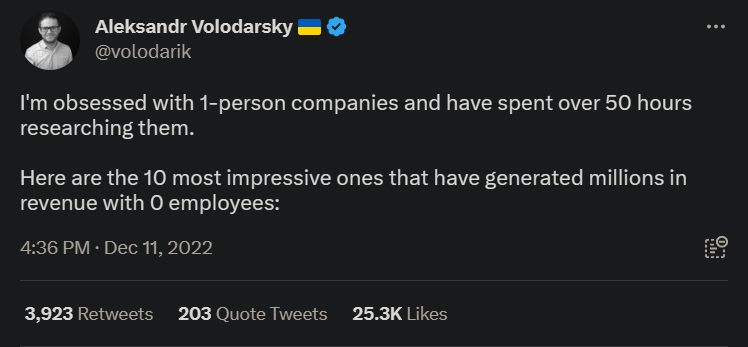
On multibillion companies’ starting points

On cold emailing
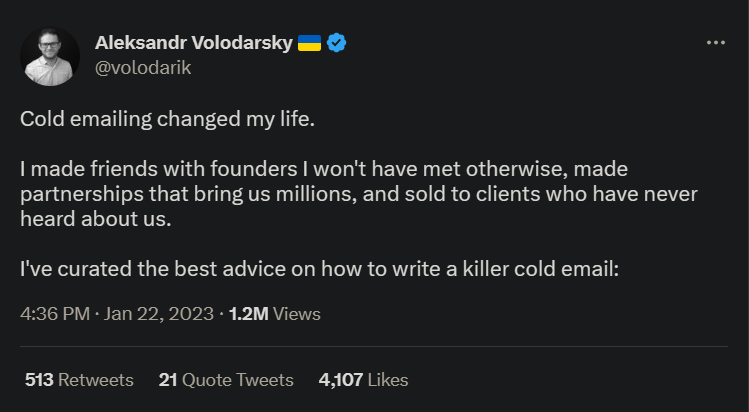
On being a wartime CEO of the Ukrainian company
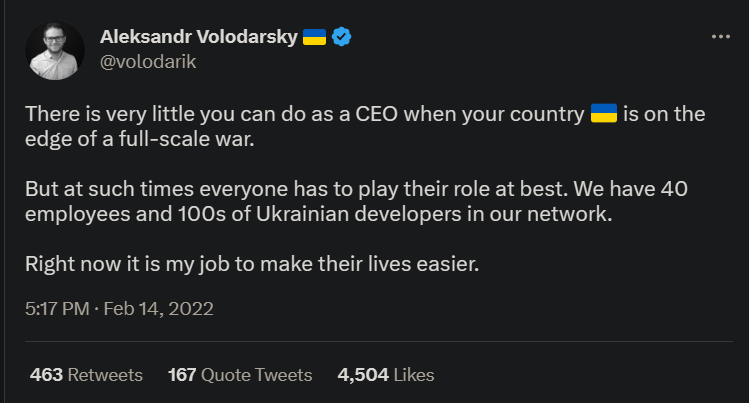
Creating catching content, boosting your online credibility, and maintaining strong ties with the much-needed audience are the pillars of a well-done social media strategy without obnoxious SMM reek. For those readers who would like to equip themselves with more opinions on the topic, we’ve prepared nine tips from influential entrepreneurs using Twitter for a lead generation without disrupting a proper social media vibe .
Six tips on how to turn Twitter into a lead-generating machine
1. JK Molina (founder of Tweet Hunter):
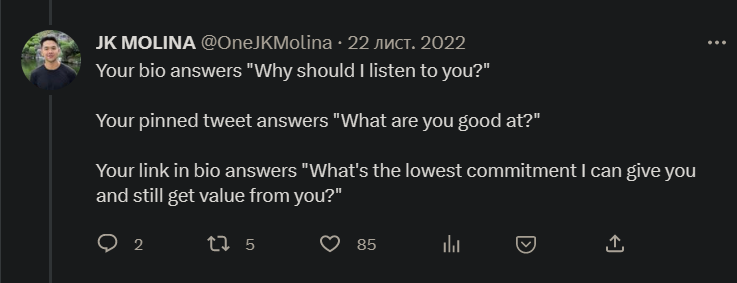
2. Justin Welsh:
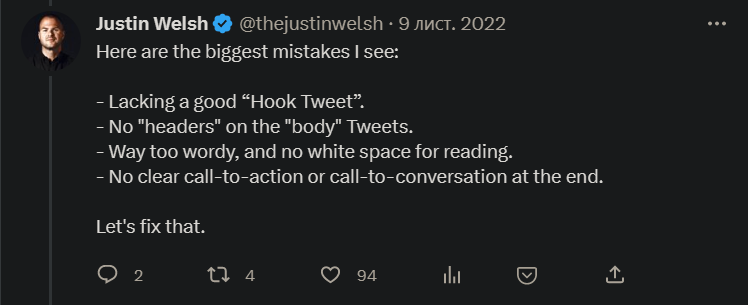
3. Dakota Robertson:
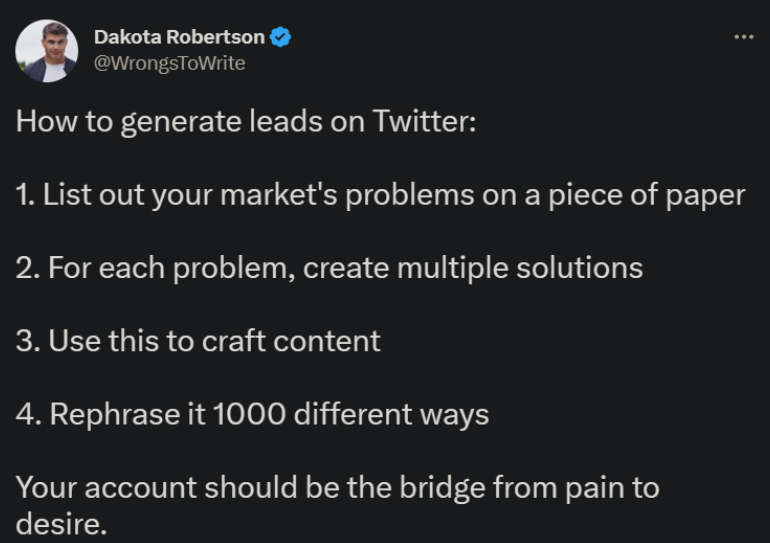
4. Rob Lennon:
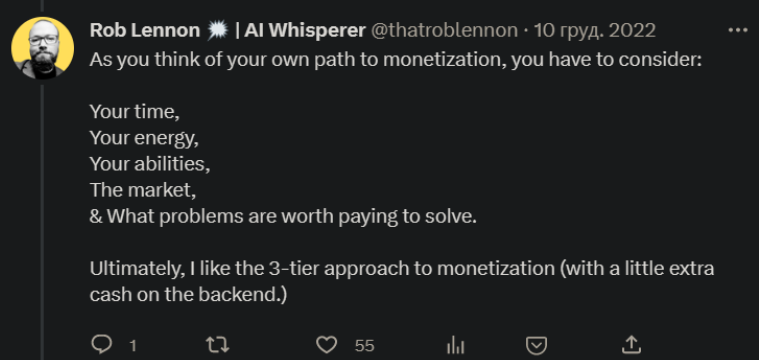
5. Jose Rosado (HyperGrowth):
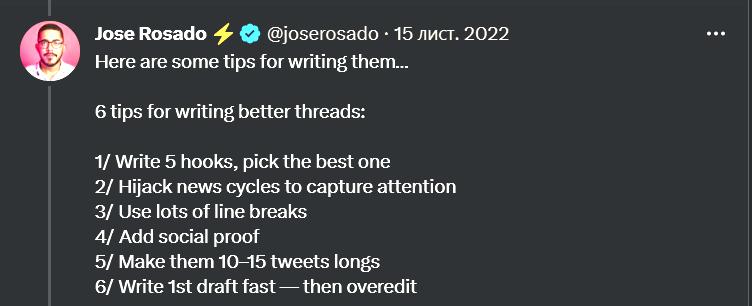
6. Tom Jacquesson (Tweet Hunter, Taplio):
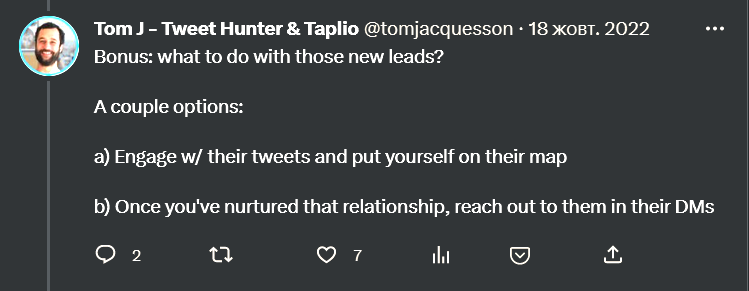
Now that you’ve read all these tips and tricks about using Twitter for lead generation, you’ll surely look at this social network from an entirely different perspective. Instead of just another tool for sharing ads and luring readers to your web page, it becomes a meticulous instrument for generating revenue via content strategies — and surely brings you many useful contacts, clients, and experiments!
Looking for developers? Check these out:
Ivan S.
// senior back-end web developer
If you are searching for the top Developer in Golang and Java, Ivan is the cream of the crop. More than 10 years of commercial experience make Ivan even more required.
Nikita P.
// senior back-end web developer
Started coding in 2017 and picked Node as his one and only; Nikita strives to achieve excellent results in any project he joins, while also being ready to grow rapidly in a startup environment.
Stanislav H.
// senior full-stack developer
A senior full-stack dev who has been in business since ‘14. He leans toward the back-end with Ruby, but he’s by no means a slouch in the front. React is also up his alley.
Want some more? Here's a FAQ!
What is social media lead generation?
Social media lead generation refers to using social media platforms to attract and engage potential customers and convert them into leads for your business. This typically involves creating content and ads tailored to your target audience and promoting them on platforms such as Facebook, Instagram, LinkedIn, and Twitter. The goal is to build awareness, interest, and trust in your brand and encourage people to take a specific action, such as filling out a form, signing up for a newsletter, or downloading an ebook.
Is Twitter a good advertising tool?
Twitter can be a good advertising tool for certain businesses and marketing objectives. The platform has a large user base and can reach a broad audience. Still, it’s especially effective for businesses that target young, tech-savvy users or those in certain industries such as news and media, technology, and entertainment.
Twitter’s advertising offerings include sponsored tweets, promoted accounts, and promoted trends, which can help you increase your visibility and reach on the platform. The platform’s targeting options, such as keywords, interests, and behaviors, allow you to hone in on your ideal audience. Twitter’s real-time nature can benefit businesses looking to reach users during live events or when news is breaking.What is auto-plug in the context of Twitter marketing?
In the context of Twitter marketing, “auto-plug” typically refers to the use of automated tools or software to promote a product or service on the platform. This can include tweeting pre-written messages, following and unfollowing users automatically, or using other methods to increase visibility and engagement with the target audience.
How many tweets do you need to go viral?
There is no set number of tweets that is guaranteed to go viral, as going viral is largely determined by factors beyond your control, such as timing, audience engagement, and luck. Going viral on Twitter means that a tweet has gained widespread popularity and has been shared and re-tweeted by a large number of users, resulting in significant exposure and reach.
Which social media is best for B2B marketing?
The best social media platform for B2B (business-to-business) marketing depends on your business’s specific target audience and marketing objectives. However, some of the most popular and effective social media platforms for B2B marketing include:
1. LinkedIn: LinkedIn is the largest professional networking platform specifically designed for B2B marketing. It is an excellent platform for building relationships with other businesses, sharing thought leadership content, and generating leads.
2. Twitter: Twitter can be an effective platform for B2B marketing, especially for businesses in technology, finance, and other industries that constantly producing news and updates.
3. Facebook: While Facebook is more commonly associated with B2C (business-to-consumer) marketing, it can also be an effective platform for B2B marketing. Facebook can be used to build relationships with other businesses and to share thought leadership content and company updates.
Explore our stacks and pages: Enzyme, React + .NET, Splunk, XSLT, npm






